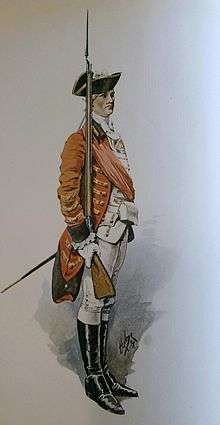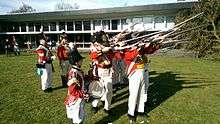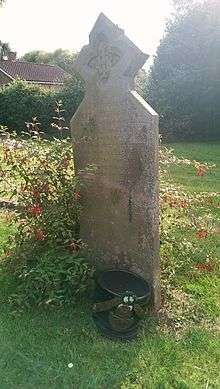East Norfolk Militia
| East Norfolk Militia | |
|---|---|
 Officer of the Norfolk Militia, 1759 | |
| Active | 1757–1881 |
| Country | Great Britain, United Kingdom |
| Type | Infantry |
| Commanders | |
| Current commander | n/a |
| Notable commanders | George Walpole, 3rd Earl of Orford |
The Norfolk Militia was formed under the Militia Act of 1757, replacing earlier less formal arrangements. From this date, better records were kept, and the men were selected by ballot to serve for longer periods. Proper uniforms and better weapons were provided, and the force was 'embodied' from time to time for training sessions.
In 1758 the Earl of Orford put the "Act for the better regulating of the Militia" into execution. This set the number of men to serve in the militia in Norfolk at 960, with the city of Norwich providing 151. The Norfolk Militia was divided into the 1st Battalion Western Regiment of the Norfolk Militia (West Norfolk Militia) and the 2nd Battalion Eastern Regiment of the Norfolk Militia (East Norfolk Militia).[1] Between 1797 and 1798 there was also a 3rd Battalion of the Norfolk Militia, but this was not re-raised in 1803.[2]
The East Norfolk Militia was, jointly with the West Norfolk, the first regiment formed under the Bill of 1757, and was also recognised as the first to offer to "march wherever they might be most serviceable to the public defence." Consideration was given by King George II "that every mark of his Royal Favour should be shown to this Corps" and that they "should be distinguished by the title of Militia Royal".[1]:289
History
On 4 June 1759 the Eastern Battalion was reviewed by the Earl of Orford on Magdalen Fairstead, just outside Norwich. The event was reported in the press, with the conduct of the men being praised and a statement that the unit could now be ready to march given four days notice.[3] The establishment of the unit was given as 1 Colonel, 1 Lt. Colonel, 1 Major, 11 Captains, 11 Lieutenants, 8 Ensigns, 1 Adjutant, 24 Sergeants, 24 drummers and 466 rank and file.[1]:23
On Wednesday 4 July 1759 both battalions began a march from Norwich to Portsmouth barracks, to accept orders from Major General Holmes.[4] Marching via Beccles, Ipswich, Colchester, Islington, and Petersfield, they arrived at Portsmouth on Tuesday 24 July. During the march, they were reviewed by King George II at Kensington Palace.[1]:27 Due to the heat, they set off soon after midnight,[5] but were described as being in good spirits.[6] By August the divisions were alternately guarding prisoners of war and undergoing training exercises.[7]
The Militia moved around the country from this point; they were quartered in Cirencester on 5 July 1760, but moved back to guard prisoners in Norfolk in July.[8] On 28 May 1761 King George awarded the two battalions of the Norfolk Militia a "Warrant for Colours".[9] In November the East Norfolk Militia was ordered to Fakenham, then to remain at Wells and Walsingham for the duration of the Fakenham Fair.[10]
Irish rebellion
In 1798 all of the officers and most of the rank and file volunteered for service in Ireland.[11]
1805 invasion scare
In 1805, after Britain had declared war on France on 18 May 1803, Napoleon turned his attention to invading England, and started to assemble an expeditionary force at Boulogne. With the British Isles threatened with invasion, the Norfolk Militia were ordered to join the Southern District (Sussex), which covered Kent east of the River Cray and Holwood Hill; Sussex; and Tilbury Fort in Essex. The GOC was Gen Sir David Dundas, Lt Gen The Earl of Chatham. Headquarters were in Canterbury.
The East and West Norfolk Militia regiments were placed, along with the Nottinghamshire Regiment of Militia, into the Infantry Brigade of Maj Gen Alexander Mackenzie Fraser, headquartered in Winchelsea, with the 712 men of the West Norfolk Militia (under Lt Col George Nelthorpe) and 698 men of the East Norfolk Militia (under Lt Col George Berney Brograve, Bt.) being barracked at Clifford Camp.[12]
Disembodiment and peace
The Militia was disembodied at Great Yarmouth in 1814, and was not called out again until 1820. In 1853 the 'Norfolk Militia Artillery was formed from detachments of West and East Norfolk Militia. 52 men transferred from the East Norfolk Militia.
The Militia was presented with new colours on 16 May 1854, and these were still being carried in 1898.[1]:108 These were presented at a public ceremony held on South Denes, Great Yarmouth, that was attended by 10,000 persons, including civic dignitaries.[1]:108 The day concluded with a ball held at the Town Hall, which had been decorated with the new colours, mirrors and stars formed of bayonets.[1]:112
An order for the provision of Militia barracks at Great Yarmouth was made in 1853. In 1855 it was noted that the government intended to convert the arsenal at Yarmouth to create Gorleston Barracks, a facility for the two field officers, 15 sergeants and 408 men of the East Norfolk Militia, with the old Great Yarmouth barracks having been converted into an Admiralty hospital.[1]:121
In 1856, the East Norfolk Militia left Great Yarmouth by train, travelling to an encampment at Colchester. At Colchester railway station they were met by the band of the Royal Essex Rifles.[13] The strength at this time was recorded as 1 Major, 13 officers, 3 sergeants and 415 men.[1]:127
On April 23 the units at Colchester, including the East Norfolk Militia, were reviewed by Prince Albert, but June 4 saw orders issued for the East Norfolk Militia to return to Great Yarmouth for disembodiment.
Thorpe rail disaster, 1874
Two serving members of the West Norfolk Militia, Sgt Major Frederick Cassell and Sgt Robert Ward, are recorded to have been killed in the Thorpe rail accident whilst returning from a fishing trip. Their bodies were recovered and they were buried with full military honours. Robert Ward had previously been part of the Coldstream Guards.[14]
Uniform

The uniform of the Militia was scarlet turned up with black.[15] Long boots were discontinued, except for mounted officers, on 12 April 1814. On 22 June 1820 epaulettes, buttons and ornaments of dress were changed from gold to silver, although serving officers were permitted to retain their old style of uniform unless called on for actual service. In January 1831 the old uniform was finally discontinued, with orders that all uniforms must meet the latest King's Regulations and include black velvet and silver epaulettes.[16]
Gold lace was restored to the Militia on 5 June 1882, at the same time as the badge of the then 4th Battalion Norfolk Regiment was changed from the castle and lion to the figure of Britannia.

Prisoner shooting
In 1799 the East Norfolk Militia was escorting French prisoners of war from Yarmouth to Norman Cross. The bell tower of Dereham church was employed as a makeshift overnight cell for these prisoners. Jean De Narde, a 28-year lieutenant and son of a notary from St. Malo, escaped from the tower, but could not leave the churchyard due to posted sentries.
Being unable to escape, De Narde chose to hide in a tree; but his absence was noted and he was soon discovered by a sergeant. De Narde ignored orders to surrender and the sergeant shot him dead. The local people of Dereham were ashamed of this killing and a monument was built by public subscription.[17]
A memorial service for Jean De Narde was held at Dereham church on 23 July 2016, including a re-enactment of the shooting and a minute's silence.
Commanding Officers
The following is a list of the commanding officers of the East Norfolk Militia up to the 1881 reorganisation.[1]
- George Walpole, 3rd Earl of Orford, Col. of the Norfolk Milita from 1759
- Lt. Col. R. Ward took command 1792
- Hon. John Wodehouse, Lord Lieutenant of Norfolk, Col. of the East Norfolk Militia, took command 1798
- Lt. Col. Charles Lucas took command 1804.
- Lt. Col. J. Stanisforth Patteson took command 1806.
- Lt. Col. W. Durrant took command in 1808.
- Lt. Col. W. Mason took command 1824.
- Col. Sir E.H.K. Lacon took command in 1860
- Col. Charles Applewaite, took command in 1881.
Notable members
- George Stracey Smyth, a Captain in the East Norfolk Militia and later Lieutenant-Governor of New Brunswick.[18]
- Sir George Berney Brograve, 2nd Baronet, a Lieutenant Colonel in the Militia and High Sheriff of Norfolk in 1802.
Successor units
In 1881, following reorganisation of the British Army as part of the Childers Reforms, the East Norfolk Militia became the 4th Battalion of the Norfolk Regiment. Later titled the Royal Norfolk Regiment, it was amalgamated with the neighbouring Suffolk Regiment to form the 1st East Anglian Regiment. In 1964, the regiment became part of the Royal Anglian Regiment.
East Norfolk Militia (re-enactment group)
The East Norfolk Militia is a Napoleonic era re-enactment group, formed in 2000 to help celebrate the bicentenary of Horatio Nelson, 1st Viscount Nelson being awarded the Freedom of the borough of Great Yarmouth.[19] In 2005 they took part in events to mark the bicentenary of the Battle of Trafalgar at the Royal Norfolk Show.[20] They perform ceremonial and guard duties for events in and around East Anglia.[21][22] in addition to taking part in living history events, and took part in the bicentenary re-enactment of the Battle of Waterloo.[23]
References
- 1 2 3 4 5 6 7 8 9 10 Harvey, Col. Sir Charles (1898). History of the 4th Battalion Norfolk Regiment (Late East Norfolk Militia). Jarrold & Sons.
- ↑ Online Database of Early British Military Buttons
- ↑ Ipswich Journal. Jun 6, 1759. Missing or empty
|title=(help) - ↑ WO Militia Marching Orders Vol.84: 3. 1759. Missing or empty
|title=(help) - ↑ Chambers, John (1829). General History of the County of Norfolk. J. Stacy.
- ↑ Ipswich Journal. Jul 14, 1759. Missing or empty
|title=(help) - ↑ London Evening Post. Aug 9, 1759. Missing or empty
|title=(help) - ↑ Marching Orders Vol.84. 1760. Missing or empty
|title=(help) - ↑ 1776 WO Militia Letter Book Vol.2: 36. 1760–1776. Missing or empty
|title=(help) - ↑ Marching Orders Vol.57: 129. Nov 20, 1761. Missing or empty
|title=(help) - ↑ Matchett, G (1822). Norfolk and Norwich Remembrancer and Vade-mecum. Matchett & Stevenson.
- ↑ HOME GUARD: THE FORCES TO MEET THE EXPECTED FRENCH INVASION 1 SEPTEMBER 1805
- ↑ The Essex Standard and Eastern Counties Advertiser. Feb 1, 1856. Missing or empty
|title=(help) - ↑ The Thorpe Railway Disaster 1874
- ↑ London Evening Post. Jul 17–19, 1759. Missing or empty
|title=(help) - ↑ Reg. order book. Jan 1831. Missing or empty
|title=(help) - ↑ The East Norfolk Militia: Jean De Narde
- ↑ Dictionary of Canadian Biography
- ↑ East Norfolk Militia march past Great Yarmouth Town Hall during the town's busy annual Maritime Festival
- ↑ East Norfolk Militia celebrate Trafalgar anniversary
- ↑ Shots of rum raised in honour of Admiral Nelson
- ↑ Trafalgar Day, Great Yarmouth, 2014.
- ↑ Waterloo 200 B Division
Bibliography
- A general history of the County of Norfolk
- Norfolk and Norwich Remembrancer and Vade-mecum
- A Plan of Disciple composed for the use of the Militia of the County of Norfolk
External links
- Grave marker for James Randall, East Norfolk Regiment of Militia, 1858
- Painting of Sir Armine Wodehouse (1714–1777), MP, Colonel of the 2nd, or Eastern Regiment of Norfolk Militia, at a Review of his Regiment near Norwich (1759)
- Unknown officer of the Norfolk Militia
- Major Money (d.1817) and the Norfolk Militia